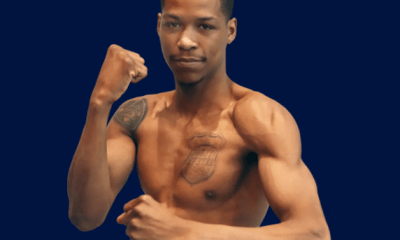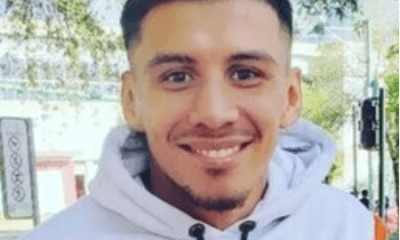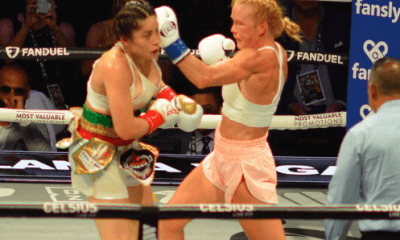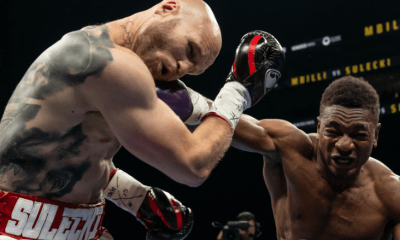Featured Articles
Peter Broudy Remembers… Don Chargin and The Olympic Auditorium
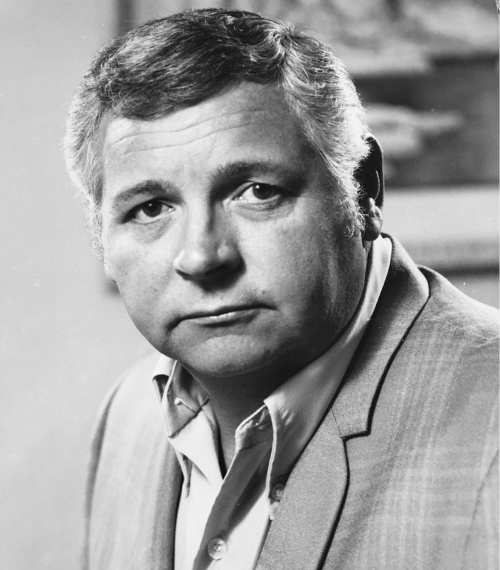
Over the past fifteen years, TSS has had the good fortune of featuring the works of highly talented boxing authors and journalists. We have a loyal fan base and we also have a loyal following from within the industry itself. We are going to be reaching out to those who answer the bell every day, those that add to the fabric of the sport, to pen something more personal and unique that may have escaped the eyes and ears of the boxing public.
The first article up is a request made upon promoter Peter Broudy, regarding the recent passing of Don Chargin, a legendary boxing figure on the West Coast. Considering Chargin’s friendship and mentoring, Peter was the perfect guy for the task, not to mention their involvement with the historic Grand Olympic Auditorium, which is part of the sport’s rich history. What follows are some of Peter’s recollections of Don, the Olympic Auditorium, and a few other names you might recognize.
Peter Broudy Remembers… Don Chargin and The Olympic Auditorium
In the fifties and sixties, boxing was a prominent sport in the United States. I was a young boy and I could hardly wait for the weekly fights. That is when I first heard the name Chargin, as he was the promoter. The fights were held in the most famous boxing venue in the world, The Olympic Auditorium at 18th and Grand in Downtown Los Angeles. Built in 1924, The Olympic hosted the best fighters in the world from the 1920’s through the 1990’s.
The fights were broadcast on local TV, long before cable TV existed. KTLA Channel 5 televised the weekly fights from the Olympic, with legendary TV and radio personality Jim Healy calling the action along with Dick Lane. This is when I first became familiar with the phrase “War-a-Week” Chargin.
Don became known as “War-a-Week” Chargin because of his great matchmaking ability. He managed to put together competitive fights each and every week, and even with free local TV, the Olympic was busting at the seams to hold over 10,000 jammed-in fans, with standing room only. And there was a wide spectrum of fans in attendance… from the most glamorous Hollywood movie stars arriving in chauffeur driven limousines, to fieldworkers from Tijuana, and everybody in between.
The fights brought the best in professional sports entertainment to Los Angeles. At that time, professional sports were limited to the Los Angeles Rams that had recently moved to LA from Cleveland, and the Dodgers that had relocated from Brooklyn in 1958. Unlike today, boxing was front-page news every week.
Besides the great wealth of world class professional fighters, Chargin also featured amateur fights before the weekly pro card began, and those fights were also televised. Many of the amateurs went on to very successful pro careers and some became world champions. Many became household names such as Mando Ramos, Frankie Crawford and Joey Orbillo. The fans loved these young stars of the future, almost as much as Los Angeles’ “Golden Boy” Art Aragon, the most popular fighter to this day in Los Angeles.
The name Don Chargin will forever be linked to the nearly 100-year-old Olympic Auditorium. Chargin will be remembered along with the great personalities of the Olympic. Aileen Eaton (the female promoter), Luis Magaña (the legendary publicist), the original ring announcer, Jimmy Lennon (father of Jimmy Lennon, Jr.) the great fight doctor, Dr. Bernard Schwartz (always wearing the white doctor smock), managers like Jackie McCoy, Benny Georgino, and never to be forgotten, “El Ruso Loco” “Da Beegman” Harry Kabakoff with those wild, crazy Hawaiian shirts.
Chargin was every bit as significant as any of the great names that fought at the Olympic Auditorium on a regular basis, such as Mando Ramos, Frankie Crawford, Joey Orbillo, Ray “Windmill” White, Big Ernie “Indian Red” Lopez, his younger brother and future world champion Danny “Little Red” Lopez, Hedgemon Lewis, Carlos Palomino, Jesus Pimentel, Ruben Navarro, and of course, the “Golden Boy” Art Aragon. All of these individuals became famous because of the platform to excel that was provided to them by “War-a-Week” Chargin.
Don’s name is synonymous with all things Olympic Auditorium, including 18th and Grand, Giant Felix Chevrolet on Figueroa, the beautiful marquis on the front of the Olympic, the “celebrity section”, the gamblers section, KTLA channel 5, Jim Healy & Dick Lane, the wannabes and the something specials, and who could forget the famous sign above the ring with the following: RI 9-5171 (The Olympic’s phone number RI-Richmond, long before area codes were used). This is the building that Don was influential in shaping and helped make boxing must see entertainment in Los Angeles.

Don Chargin was both my friend and mentor for well over 30 years. I love him like family. I first met him when I attended a California State Athletic Commission monthly meeting in the early 1980s in Palm Springs, California. I was lucky enough to meet both Don and his lifetime partner and love of his life, Lorraine. At the commission meeting, Don kindly introduced me to Aileen Eaton, the legendary promoter at the Olympic Auditorium. Though she was wheelchair bound, she was, even at her advanced age, a remarkable woman. Aileen, Lorraine and Don were all involved with the Olympic, and “War-a-Week” Chargin is known for the memorable bouts featured there from 1965-1984.
Don was a licensed promoter for 69 years and became the most knowledgeable man in boxing. For over half a century, he taught many people about boxing and the art of promoting. From the day I first met him, he was always there for me to answer any questions I had. When I took over promotions at the Olympic Auditorium in the mid 1990’s, Don’s advice was invaluable.
The Needleman family were the owners of the Olympic Auditorium. While we were negotiating, I made a promise to them that I could fill the Olympic and bring it back as close as possible to the glory days of Eaton and the Chargins. I reached out to Don and we discussed the formula required in order to bring instant success back to the grand old building that, since being renovated, had still not had much success in that first year under Bob Arum’s Top Rank. Chargin knew that I wanted to bring the spotlight back to the greatest venue in the world, rather than simply using the Olympic as a sound stage for ESPN shows.
At that time Don, along with Dan Duva, was managing the career of Ramon “Yory Boy” Campas. In a fight for the IBF welterweight title in September of 1994, Campas experienced his first loss to rising star, Puerto Rico’s Felix Trinidad. There were many fight fans who wrote “Yory Boy” off after the fourth round TKO, especially those from his home country of Mexico. We decided that Campas was the right guy for the Olympic.
The LA Times printed a story by Tim Kawakami on June 18th, 1995 entitled “From Glory Days to Yory Days. Campas has breathed new life into Grand Olympic Auditorium.” Chargin is quoted as saying, “I told Peter he’d be the guy to draw at the Olympic. Number 1, he’s a real Mexican. He’s from there. He’s had the majority of his fights in Mexico, he will take two punches to land one, and he’s a puncher, which they like.” The way the guy meets the people and shakes hands, he just typifies the fighter from below the border that they really like. “I will admit they needed each other,” Chargin said of the fighter and the old building. “His career, after losing to Trinidad, needed a boost and the Olympic needed a boost.”
The rest is history, as “Yory Boy’” brought a huge turnout to the Olympic. And not just once, he came back a short time later and again delivered a full house and thrilling fight. The fans loved it. “Yory Boy” was back. At the end of Tim’s article about “Yory Boy” and the venue, Chargin emphasized that the key was to do what the old Olympic did, keep finding young fighters who can draw the real fight crowd. “Peter’s not afraid to work, so he’s probably going to be successful,” stated Chargin. Which is something Top Rank, for all its power and name fighters, could not do. Chargin also said,“I heard that Arum told (Top Rank Matchmaker) Bruce Trampler ‘Your friend Chargin gave the new promoter “Yory Boy”. Why didn’t he give him to us?’” “Thing was,” Chargin said, “they never asked.”
Don Chargin must be credited for The Olympic Auditorium taking off again in the 90s.
Don and I talked every day and each conversation always evolved into a discussion of what fighters to bring to the Olympic. Once again, Don helped me out and was able to get Hector “Macho” Camacho, who was one of my most favorite fighters. We both were very confident that Hector was the type of fighter that could fill the Olympic Auditorium. Even though Hector was not a Mexican National, we both felt that the type of fans at the Olympic appreciated Hector’s immense talent. And because he fought in weight divisions that Mexican fans closely follow, they had seen him fight many times on TV. It is important to note that in boxing, not only was Hector not a Mexican, he was also the natural enemy, a Puerto Rican. Best of all, Hector had never fought in Southern California. In fact, the only time Hector fought in California was many years before, when he fought for my man Don in Northern California. We both knew that the Los Angeles fans would appreciate being treated to this great showman.
The only thing was that I had some reservations in the back of my mind because of all the crazy stories that were out there about Hector. Don assured me that I would love working with Hector, to forget all the craziness that people saw on TV. Don told me that Hector was a real gentleman, very business-like, and was a promoter’s best friend because no one could hype a fight the way Hector could. Hector understood that promoters and fighters needed to work together so that the show would be highly anticipated and a truly memorable night for the fans. Everything Don told me about Hector was true, and the Olympic Auditorium was rockin’ the night Hector fought.
Don shared a funny story about Hector. Years before, when Hector fought for Don, after the fight was over, Hector asked Don to please hold his money and later, he would let Don know where to send it. I believe his purse was $80,000, so we are talking about a significant amount of money. Don deposited Hector’s purse into a separate account. Years went by, and Don told me Hector finally called him. To the best of my recollection, the conversation went almost exactly as follows: Hector introduced himself, “Mr. Chargin, this is Hector.” After Don acknowledged him, Hector said, “Mr. Chargin, do you still have the $80,000?” Don told me that although he had a big smile on his face, he said in a serious tone, “Hector, I don’t have the $80,000.” Don waited for Hector to say something, but there was just silence on the other end. Don finally spoke up, saying “Hector, I don’t have the $80,000, but what I do have is your $80,000 plus whatever interest has accrued after all these years.” Hector laughed and told Don how much he loved him and then gave him the address of where to send the money.
What’s ironic about this story is that after Hector fought for me at the Olympic, we had a similar situation. After Hector’s fight, which the crowd loved, I went down to Hector’s dressing room. I wanted to thank him for a great show and tell him what a pleasure it was working with him and his team. Hector pulled me into an adjoining room, so that we were alone and could have a private conversation. Things proceeded as follows: Hector said to me, “Peter, the whole experience of fighting at the Olympic was great. I enjoyed the public workouts every day at Brooklyn Gym and I was happy doing all the interviews.” (Hector went by limo every night to different radio and tv stations, hyping the fight. He was even a guest on the Monday Night Football game telecast the week of the fight. I never saw any fighter work that hard to help a promotion, he really understood the whole boxing business.) Hector continued the conversation and said, “Look Peter, I know you took a big risk putting me on a show with no television. I know I am expensive, especially with all the plane flights I requested, and that you housed us in a beautiful hotel for almost two weeks. Even though I know it was a great show and a big crowd, I know you couldn’t have made any money, and you may have even lost money. I know what you’re doing with the Olympic and I feel honored to have fought in a building with such history.” (After the fight, I still owed Hector a balance of $25,000.) Hector continued, “Why don’t you hold my $25,000 and in a month or so, you can start sending me $5000 a month until the entire purse is paid.”
That was the Hector Camacho I knew, not the Hector “Macho” Camacho the public saw on their TVs. Once again, it all happened because of Don Chargin and Hector’s manager Mike Acri. I could never thank Hector, Mike and especially Don enough.
I wanted to share another side of Don Chargin with you. He was co-promoting a world championship fight with Don King. They were all busy during the week leading up to the fight. One day Don was in his hotel room with some people involved with the show. There was a loud knock on the door and Don answered it. One of the individuals involved with the promotion was there, out of breath, and excitedly telling Don that he had to get down to the lobby as fast as possible. Don told the guy to calm down, catch his breath, and tell him what the problem was. The guy told Don that his wife Lorraine was arguing jaw to jaw with Don King in the lobby and he needed to get down to the lobby asap to save Lorraine from King. With a big smile on his face, Don told the guy that Lorraine wasn’t the one who needed saving, it was King! Lorraine was as tough as anyone in boxing and that is one of the reasons why Don and Lorraine Chargin made such a great match as partners in promoting and partners in life.
Don has had a huge impact both on my life and on the sport of boxing. He was not only instrumental, but also essential to the success of the Grand Olympic Auditorium. Chargin was a remarkable matchmaker and promoter. Personally, I consider him to be the Godfather of professional prizefighting. The boxing world has lost a legend in Don Chargin and he will be greatly missed.
By Peter Broudy
Check out more boxing news on video at The Boxing Channel
-

 Featured Articles3 weeks ago
Featured Articles3 weeks agoAvila Perspective, Chap. 330: Matchroom in New York plus the Latest on Canelo-Crawford
-

 Featured Articles1 week ago
Featured Articles1 week agoVito Mielnicki Jr Whitewashes Kamil Gardzielik Before the Home Folks in Newark
-

 Featured Articles4 weeks ago
Featured Articles4 weeks agoAvila Perspective, Chap 329: Pacquiao is Back, Fabio in England and More
-

 Featured Articles3 weeks ago
Featured Articles3 weeks agoOpetaia and Nakatani Crush Overmatched Foes, Capping Off a Wild Boxing Weekend
-

 Featured Articles2 weeks ago
Featured Articles2 weeks agoCatching Up with Clay Moyle Who Talks About His Massive Collection of Boxing Books
-

 Featured Articles3 weeks ago
Featured Articles3 weeks agoFabio Wardley Comes from Behind to KO Justis Huni
-

 Featured Articles1 week ago
Featured Articles1 week agoMore Medals for Hawaii’s Patricio Family at the USA Boxing Summer Festival
-

 Featured Articles4 weeks ago
Featured Articles4 weeks agoDelving into ‘Hoopla’ with Notes on Books by George Plimpton and Joyce Carol Oates

